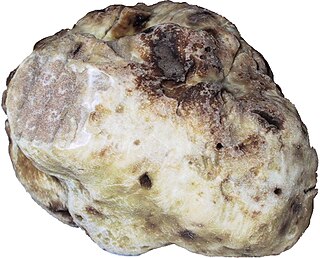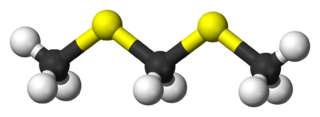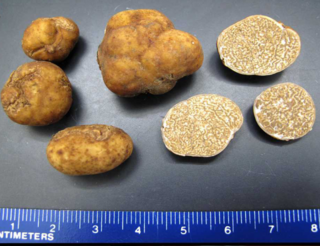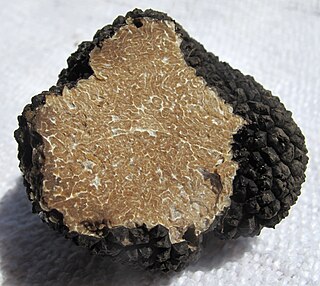
Edible mushrooms are the fleshy fruit bodies of numerous species of macrofungi. Edibility may be defined by criteria including the absence of poisonous effects on humans and desirable taste and aroma. Mushrooms that have a particularly desirable taste are described as "choice". Edible mushrooms are consumed for their nutritional and culinary value. Mushrooms, especially dried shiitake, are sources of umami flavor.

A truffle is the fruiting body of a subterranean ascomycete fungus, one of the species of the genus Tuber. More than one hundred other genera of fungi are classified as truffles including Geopora, Peziza, Choiromyces, and Leucangium. These genera belong to the class Pezizomycetes and the Pezizales order. Several truffle-like basidiomycetes are excluded from Pezizales, including Rhizopogon and Glomus. Truffles are ectomycorrhizal fungi, so they are found in close association with tree roots. Spore dispersal is accomplished through fungivores, animals that eat fungi. These fungi have ecological roles in nutrient cycling and drought tolerance.
Fungiculture is the cultivation of fungi such as mushrooms. Cultivating fungi can yield foods, medicine, construction materials and other products. A mushroom farm is involved in the business of growing fungi.

A chocolate truffle is a French chocolate confectionery traditionally made with a chocolate ganache centre and coated in cocoa powder, coconut, or chopped nuts. A chocolate truffle is handrolled into a spherical or ball shape. The name derives from the chocolate truffle's similarity in appearance to truffles, a tuber fungus. It was created in the city of Chambéry by the pastry chef Louis Dufour.
The truffle is the edible body of fungi in the genus Tuber.

Tuber magnatum, the white truffle, is a species of truffle in the order Pezizales and family Tuberaceae. It is found in southern Europe, the Balkans and Thailand.

2,4-Dithiapentane is an organosulfur compound, and is the simplest alkyl dithioether. It is a colorless liquid with a strong odor, reminiscent of freshly prepared mustard in the pure form.

Tuber lyonii, also known as the American brown truffle or the pecan truffle, is a species of truffle native to North America. The pecan truffle is so named because it is most commonly found in pecan orchards, in association with the pecan tree. However, the pecan is not its only symbiote. Formerly considered nothing more than a nuisance by pecan farmers, the pecan truffle has been gaining in popularity as an edible mushroom in recent years and can fetch over $160 per pound at market.

The summer truffle or burgundy truffle is a species of truffle, found in almost all European countries.

Tuber oregonense, commonly known as the Oregon white truffle, is a species of edible truffle in the genus Tuber. Described as new to science in 2010, the North American species is found on the western coast of the United States, from northern California to southern British Columbia west of the Cascade Range. A mycorrhizal fungus, it grows in a symbiotic association with Douglas fir. It overlaps in distribution with the closely related T. gibbosum, but they have different growing seasons: T. oregonense typically appears from October through March, while T. gibbosum grows from January to June. The fruit bodies of the fungus are roughly spherical to irregular in shape, and resemble small potatoes up to 5 cm (2 in) in diameter. Inside the truffle is the gleba, which is initially white before it becomes a marbled tan color. The large, often thick-walled, and strongly ornamented spores are produced in large spherical asci. The truffle is highly prized for its taste and aroma. Some individuals have claimed success in cultivating the truffles in Christmas tree farms.

Tuber gibbosum, commonly known as the Oregon white truffle, is a species of truffle in the genus Tuber. It is found in the Pacific Northwest region of the United States, where it grows in an ectomycorrhizal association with Douglas-fir. It is commercially collected between as early as October and into March.

Tuber is a genus in the fungal family Tuberaceae, with estimated molecular dating to the end of the Jurassic period. It includes several species of truffles that are highly valued as delicacies.

Kalapuya brunnea is a species of truffle in the monotypic fungal genus Kalapuya. The truffle occurs only in the Pacific Northwest region of the United States, in western Oregon and northern California. Known locally as the Oregon brown truffle, it was formerly thought to be an undescribed species of Leucangium until molecular analysis demonstrated that it was distinct from that genus. The truffle is reddish brown with a rough and warty outer skin, while the interior spore-producing gleba is initially whitish before developing greyish-brown mottling as it matures. Mature truffles have an odor resembling garlicky cheese, similar to mature Camembert. The species has been harvested for culinary purposes in Oregon.

Tuber polyspermum is a species of truffle in the family Tuberaceae. Found in China, it was described as new to science in 2011. Fruit bodies of the truffle are small and brown, measuring up to 1.5 cm (0.6 in) in diameter.
Tuber anniae is a species of truffle in the genus Tuber. The truffle is purported to be uncommon, but is primarily found in the United States Pacific Northwest. Recently the fruiting of closely related taxa have been found in the Baltic Rim countries, primarily forests dominated by Scots pine in eastern Finland.

Tuber melanosporum, called the black truffle,Périgord truffle or French black truffle, is a species of truffle native to Southern Europe. It is one of the most expensive edible fungi in the world. In 2013, the truffle cost between 1,000 and 2,000 euros per kilogram.

Tuber donnagotto is a species of truffle in the family Tuberaceae. Described as a new species in 2012, it is found in Croatia. The black truffle measures 2–7 cm (0.8–2.8 in) in diameter.

Alisma canaliculatum, commonly known as channelled water plantain, is a species of plants in the Alismataceae. It is native to Japan, Korea, the Ryukyu Islands, Taiwan, the Kuril Islands, and China.

Leucangium carthusianum is a species of ascomycete fungus. It is commonly known as the Oregon black truffle. It is found in the Pacific Northwest region of North America, where it grows in an ectomycorrhizal association with Douglas-fir. It is commercially collected, usually assisted by a specially trained truffle dog. Mature fruiting bodies can be dug up mostly during winter, but the season can extend from September through April.

Tuber borchii, known as the whitish truffle or bianchetto truffle, is a small, common species of edible truffle excellent for use in cuisine.
















